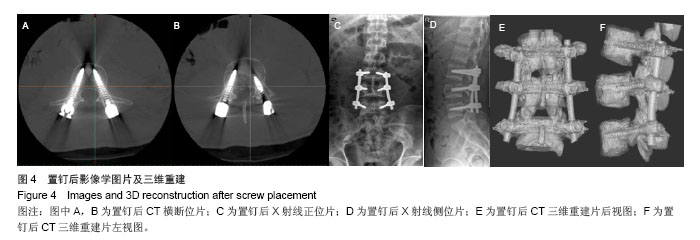| [1]Karim A, Mukherjee D, Gonzalez-Cruz J, et al.Accuracy of pedicle screw placement for lumbar fusion using anatomic landmarks versus open laminectomy: a comparison of two surgical techniques in cadaveric specimens.Neurosurgery. 2006;59(1 Suppl 1):ONS13-19; discussion ONS13-19.
[2]Karim A, Mukherjee D, Ankem M, et al.Augmentation of anterior lumbar interbody fusion with anterior pedicle screw fixation: demonstration of novel constructs and evaluation of biomechanical stability in cadaveric specimens.Neurosurgery. 2006; 58(3):522-527; discussion 522-527.
[3]Austin MS, Vaccaro AR, Brislin B, et al.Image-guided spine surgery: a cadaver study comparing conventional open laminoforaminotomy and two image-guided techniques for pedicle screw placement in posterolateral fusion and nonfusion models.Spine (Phila Pa 1976). 2002; 27(22): 2503-2508.
[4]Zeiller SC, Lee J, Lim M, et al.Posterior thoracic segmental pedicle screw instrumentation: evolving methods of safe and effective placement.Neurol India. 2005; 53(4):458-465.
[5]Sagi HC, Manos R, Benz R,et al.Electromagnetic field-based image-guided spine surgery part one: results of a cadaveric study evaluating lumbar pedicle screw placement. Spine (Phila Pa 1976). 2003;28(17):2013-2018.
[6]Mason A, Paulsen R, Babuska JM, et al.The accuracy of pedicle screw placement using intraoperative image guidance systems.J Neurosurg Spine. 2014; 20(2):196-203.
[7]Tian NF, Huang QS, Zhou P, et al.Pedicle screw insertion accuracy with different assisted methods: a systematic review and meta-analysis of comparative studies.Eur Spine J. 2011; 20(6):846-859.
[8]Lim MR, Girardi FP, Yoon SC,et al.Accuracy of computerized frameless stereotactic image-guided pedicle screw placement into previously fused lumbar spines.Spine (Phila Pa 1976). 2005 1;30(15):1793-1798.
[9]Nottmeier EW, Pirris SM, et al.Three-dimensional image-guided placement of S2 alar screws to adjunct or salvage lumbosacral fixation.Spine J. 2010; 10(7):595-601.
[10]Reinhold M, Bach C, Audigé L, et al.Comparison of two novel fluoroscopy-based stereotactic methods for cervical pedicle screw placement and review of the literature.Eur Spine J. 2008; 17(4):564-575.
[11]Devito DP, Kaplan L, Dietl R,et al.Clinical acceptance and accuracy assessment of spinal implants guided with SpineAssist surgical robot: retrospective study.Spine (Phila Pa 1976). 2010;35(24):2109-2115.
[12]Modi H, Suh SW, Song HR, et al.Accuracy of thoracic pedicle screw placement in scoliosis using the ideal pedicle entry point during the freehand technique.Int Orthop. 2009;33(2): 469-475.
[13]Zausinger S, Scheder B, Uhl E, et al.Intraoperative computed tomography with integrated navigation system in spinal stabilizations.Spine (Phila Pa 1976). 2009; 34(26):2919-2926.
[14]Gloria A, Russo T, De Santis R, et al.3D fiber deposition technique to make multifunctional and tailor-made scaffolds for tissue engineering applications.J Appl Biomater Biomech. 2009; 7(3):141-152.
[15]Hoque ME, Chuan YL, Pashby I.Extrusion based rapid prototyping technique: an advanced platform for tissue engineering scaffold fabrication.Biopolymers. 2012; 97(2): 83-93.
[16]Carletti E, Motta A, Migliaresi C.Scaffolds for tissue engineering and 3D cell culture.Methods Mol Biol. 2011; 695:17-39.
[17]师继红,陆声,张元智,等.数字化脊柱椎弓根导航模板在胸腰椎骨折中的应用[J].中华创伤骨科杂志,2008,10(2):138-141.
[18]张少杰,王星,史君,等. 数字化导航模板辅助儿童胸椎椎弓根螺钉置钉的准确性[J].中国组织工程研究,2014,18(35): 5660-5665.
[19]高方友,王曲,刘窗溪,等.个体化3D打印模型辅助后路螺钉内固定治疗颅颈交界区畸形[J].中华神经外科杂志,2013,29(9): 896-901.
[20]Toyone T,Takahashi K,Kitahara H,et al.Visualisation of symptomatic nerve roots.Prospective study of contrast- enhanced MRI in patients with lumbar disc hemiation. J Bone Joint Surg Br.1993;75(4):529-533.
[21]Fairbank JC,Pynsent PB.The Oswestry disability index. Spine. 2000;25:2940-2952.
[22]陈玉兵,陆声,徐永清,等.个体化导航模板在胸椎椎弓根螺钉置入中的初步临床应用[J].中国脊柱脊髓杂志,2011,21(8): 1156-1160.
[23]Hu Y, Yuan ZS, Spiker WR,et al.Deviation analysis of C2 translaminar screw placement assisted by a novel rapid prototyping drill template: a cadaveric study.Eur Spine J. 2013;22(12):2770-2776.
[24]Merc M, Drstvensek I, Vogrin M, et al.A multi-level rapid prototyping drill guide template reduces the perforation risk of pedicle screw placement in the lumbar and sacral spine.Arch Orthop Trauma Surg. 2013;133(7):893-899.
[25]Lu S, Xu YQ, Lu WW, et al.A novel patient-specific navigational template for cervical pedicle screw placement. Spine (Phila Pa 1976). 2009; 34(26):E959-966.
[26]Lu S, Xu YQ, Zhang YZ, et al.Rapid prototyping drill guide template for lumbar pedicle screw placement.Chin J Traumatol. 2009;12(3):177-180.
[27]Lu S, Xu YQ, Zhang YZ, et al.A novel computer-assisted drill guide template for lumbar pedicle screw placement: a cadaveric and clinical study.Int J Med Robot. 2009;5(2): 184-191.
[28]Merc M, Drstvensek I, Vogrin M, et al.Error rate of multi-level rapid prototyping trajectories for pedicle screw placement in lumbar and sacral spine.Chin J Traumatol. 2014; 17(5): 261-266.
[29]Holly LT, Foley KT.Three-dimensional fluoroscopy-guided percutaneous thoracolumbar pedicle screw placement. Technical note.J Neurosurg. 2003;99(3 Suppl):324-329. |

.jpg)
.jpg)
.jpg)